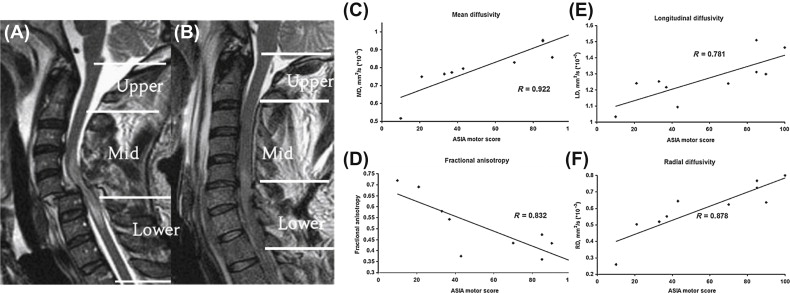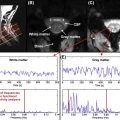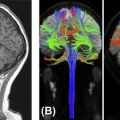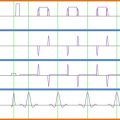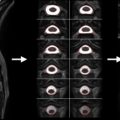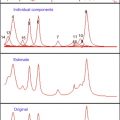Abstract
In vivo spinal cord imaging is now commonly used to diagnose patients with neurodegenerative disorders. Quantitative MRI (qMRI) techniques applied to the spinal cord show promise for predicting prognosis and monitoring treatment response in clinical practice and in treatment trials. European guidelines on the use of neuroimaging in the management of amyotrophic lateral sclerosis (ALS) have recommended incorporating qMRI into new clinical trials as exploratory outcomes. In biomedical research, qMRI can also be used to obtain new insights into disease pathophysiology. In this chapter, we will discuss the results of studies that have applied spinal cord qMRI to neurodegenerative diseases of the spinal cord, including multiple sclerosis, neuromyelitis optica, spinal cord injury, cervical spondylitic myelopathy, syringomyelia, ALS, spinal tumors, spinal vascular anomalies, and rarer spinal cord disorders.
Keywords
Amyotrophic lateral sclerosis (ALS), Brachial plexus injury, Cervical spondylitic myelopathy, Diffusion tensor imaging, Diffusion-weighted imaging, Magnetization transfer, Multiple sclerosis (MS), Neurological disease, Neuromyelitis optica (NMO), Proton spectroscopy, Spinal arteriovenous malformation (AVM), Spinal cord, Spinal tumors, Tractography
1.1.1
Introduction
Neuroaxonal injury of the spinal cord occurs in a broad spectrum of clinically and pathologically heterogeneous neurodegenerative diseases, typically with serious clinical consequences for patients. Typically, the clinical syndrome produced by injury to the spinal cord includes weakness or paralysis of the limbs and trunk, with sensory disturbance and dysfunction of the gastrointestinal and genitourinary sphincters. The spinal cord is therefore an important region of interest for biomedical research. However, magnetic resonance imaging (MRI) of the spinal cord is more challenging than that of the brain due to the smaller cross-sectional area of the spinal cord, motion artifacts from cerebrospinal fluid (CSF) flow with each cardiac and respiratory cycle, and susceptibility to artifacts from surrounding tissues. Advances in neuroimaging techniques and postprocessing have allowed progress to be made in recent years, with a subsequent rise in the number of studies investigating spinal cord diseases using MRI.
As opposed to structural MRI (e.g., T1- or T2-weighted imaging), quantitative MRI (qMRI) aims at providing values that are intrinsic to the tissue properties. qMRI has the advantage of providing absolute and normative values that could be used for diagnosis, prognosis, multiple-site studies, and ultimately clinical trials.
The development of new quantitative MRI (qMRI) techniques, which are more sensitive to change in underlying tissue microstructure and metabolism, is providing insights into the pathogenesis of a growing number of neurological diseases, and is showing promise for studying potential biomarkers of disease progression.
Thoughtfully designed mechanistic MRI studies can complement histopathological studies in understanding pathophysiological processes occurring in vivo, helping to identify important mediators of disease and therefore inform rational drug design. The insights gained from recent studies into cellular and pathophysiological abnormalities in multiple sclerosis (MS) have aided our understanding of the disease and may be valuable in future therapeutic trials of neuroprotective agents. It is predicted that qMRI will play an important role in drug trials, since qMRI-derived measures can be used as biomarkers of disease progression and to monitor treatment response. In addition, it is anticipated that qMRI might be used to risk stratify and characterize patients on entry into trials. A recent study showing that longitudinal changes in whole-brain and tract-specific diffusion tensor imaging (DTI) indices and the magnetization transfer ratio (MTR) can be reliably quantified, suggesting that clinical trials using these outcome measures are feasible. While similar, longitudinal studies in patients with spinal cord diseases are currently lacking, this will no doubt be the focus of future work. In fact, it is essential that reliable imaging biomarkers of the spinal cord are validated to prepare us for the emergence of neuroprotective drugs.
This chapter will briefly review the qMRI techniques most commonly applied to the spinal cord, and then focus on reviewing data from qMRI studies in patients with neurodegenerative spinal cord disease, and in animal models. The clinical and pathophysiological significance of the results of these studies will be discussed, and future directions of research will be proposed (studies discussed are summarized in Table 1.1.1 ). DTI, MR spectroscopy, and magnetization transfer imaging will also be discussed in more detail in Chapter 3 , Chapter 5 of this book.
| Studies | Field Strength | Disease | Region of Interest | Findings |
|---|---|---|---|---|
| Brex et al. | 1.5 T | CIS | 15 mm of cord, centered at C2/3 | Spinal cord area was significantly smaller in patients with abnormal brain MRI at presentation |
| Losseff et al. | 1.5 T | MS | 15 mm of cord, centered at C2/3 | Strong correlation between spinal cord area and EDSS. Greatest cord volume loss in patients with progressive MS |
| Ingle et al. | 1.5 T | PPMS | 15 mm of cord, centered at C2/3 | Correlation between spinal cord area and EDSS. Rates of cord atrophy and brain atrophy over 5 years do not correlate |
| Kendi et al. | 1.5 T | MS | C3–7 | Lower NAA in patients than controls |
| Ciccarelli et al. | 1.5 T | RRMS (spinal cord relapse) | C1–3 | NAA was lower in patients than controls and correlated with upper limb function; Ins concentration in patients correlated with EDSS. FA was lower in posterior columns and lateral corticospinal tracts of patients; RD correlated with disability |
| Blamire et al. | 2 T | MS | C2/3 | Lower NAA in patients than controls. Spinal NAA correlated with the cerebellar subscore of the neurological assessment |
| Henning et al. | 3 T | MS | C2/3 | Lower NAA and Ins and elevated Cho in a single MS patient compared to controls |
| Marliani et al. | 3 T | MS | C2/3 | Lower NAA and elevated Ins and Cho in patients compared to controls |
| Ciccarelli et al. | 1.5 T | RRMS (spinal cord relapse) | C1–3 | Lower NAA at onset of relapse, which recovers over 6 months in patients who improve clinically |
| Ciccarelli et al. | 3 T | NMO and RRMS | C1–3 | Lower Ins:Cr ratios in NMO patients compared to RRMS and controls |
| Valsasina et al. | 1.5 T | MS | C1–5 | Decreased FA in patients with MS. Average cord FA correlates with EDSS |
| Oh et al. | 3 T | MS | C3–4 | FA, MD, RD, AD, and MTR are significantly different between patients and controls and correlate with sensorimotor function |
| Agosta et al. | 3 T | MS | C2/3 | Lower FA and higher MD in patients than controls. Cord FA lower in PPMS than RRMS. FA at baseline predictive of disability on follow-up (mean 2.4 years) |
| Freund et al. | 1.5 T | RRMS (spinal cord relapse) | C1–3 | RD at onset of spinal cord relapse predicts clinical recovery |
| Rovaris et al. | 1.5 T | PPMS | Cervical cord | Average MTR lower in PPMS patients than controls |
| Filippi et al. | 1.5 T | MS | Cervical cord | Patients had lower average MTR of the cervical cord than controls. Lowest MTR histogram peaks were seen in PPMS. Peak position and height of MTR histogram were predictive of locomotor disability |
| Rovaris et al. | 1.5 T | Early, nondisabling RRMS | Cervical cord | Average cord MTR and mean histogram peak height values did not differ between patients and controls |
| Rovaris et al. | 1.5 T | CIS | Cervical cord | Mean values of MTR histogram-derived metrics were not different between CIS patients and healthy controls |
| Charil et al. | 1.5 T | RRMS | Cervical cord | Average cervical cord MTR was correlated with a relapse rate over 18 months |
| Agosta et al. | 1.5 T | RRMS | Cervical cord | Spinal gray matter average MTR lower in RRMS than controls, and correlates with EDSS |
| Cheran et al. | 3 T | SCI | Whole cord | Reduction in FA, MD, and AD throughout the cervical cord, with maximal FA reduction at site of T2-weighted signal abnormality |
| Shanmuganathan et al. | 3 T | SCI | Whole cord | Reductions in whole-cord ADC, ADC, and FA at injury site compared with controls |
| Elliot et al. | 3 T | Chronic whiplash | C1–C3 | Lower NAA:Cr ratios (but not Cho:Cr ratios) than healthy controls |
| Kachramanoglou et al. | 3 T | Brachial plexus reimplantation | C1–C3 | Increased Ins:Cr ratios in patients compared to controls |
| Kara et al. | 3 T | CSM | Increase in ADC and decrease in FA at site of the stenosis | |
| Holly et al. | 1.5 T | CSM | C1–C3 | Lower NAA:Cr ratio in patients, with lactate peaks detected in nearly half of patients with T2-weighted signal abnormality |
| Hatem et al. | Syringomyelia | C3–C7 | Decreased FA. Mean FA correlates with clinical scores | |
| Nair et al. | 3 T | ALS | C1–C6 | FA 12% lower than controls RD 15% higher than controls No difference in MD and AD between patients and controls |
| Carew et al. | 3 T | ALS and presymptomatic SOD1-positive patients | C1–2 | NAA:Cr and NAA:Ins ratios reduced in SOD1+ subjects and ALS compared to controls Ins:Cr reduced in SOD1+ but not ALS NAA:Cho reduced in ALS but not SOD1+ subjects |
| Vargas et al. | 1.5 T | Cohort of mixed spinal tumors | Reduction in FA. ADC increased in 3 out of 5 patients | |
| Ducreux et al. | 1.5 T | Spinal astrocytoma | Cervical and thoracic cord | Reduced FA |
| Ozanne et al. | 1.5 T | Spinal AVMs | Cervical cord | Reduced FA. FA reduction associated with clinical scores |
| Qian et al. | 3 T | NMO | C1–C6 | Reduced FA and increased RD and MD. Good correlation between DTI metrics and clinical scores |
1.1.2
Quantitative MRI Techniques
Diffusion-weighted imaging is sensitive to microstructural tissue damage, including axonal orientation and demyelination.
Magnetization transfer imaging provides information on the structural integrity of the spinal cord and is most often used to derive information regarding myelination status.
Functional MRI measures neuronal activity by detecting associated changes in blood flow.
MR spectroscopy is sensitive to metabolic changes occurring in pathology that reflect important underlying biological mechanisms.
Volumetric imaging offers the possibility of calculating atrophy measurements, which give information about axonal loss, especially when repeated over time.
1.1.2.1
Diffusion Tensor Imaging
Diffusion imaging methods in the spinal cord are extensively described in Chapter 3 . The DTI model can be used to derive indices that quantitatively describe the directional diffusivity of extracellular water within white matter tracts. Data from animal studies have suggested that DTI-derived indices reflect underlying tissue structure. In particular, in animal models, such as experimental allergic encephalomyelitis (EAE), demyelination within white matter tracts leads to an increase in radial diffusivity (RD), while axonal loss is expected to cause a reduction in axial diffusivity (AD) (see Chapter 3.1 ). However, the situation is more complicated in human diseases, and it is likely that both demyelination and axonal loss influence both RD and AD; furthermore, changes in RD can be observed in animal models even in the absence of myelin changes.
Among the best known DTI parameters is fractional anisotropy (FA), which reflects the underlying tissue microstructure, including the coherence of white matter fibers. In addition to FA, RD, and AD, the mean diffusivity (MD) can be obtained. This parameter is very sensitive to a general change in tissue microstructure that allows water molecules to move less or more freely; for example, a reduction of the MD has been detected following acute neurological insults, but in chronic neurological disease, or where cellular necrosis leads to increased membrane permeability, a relative increase in the MD value can be seen.
Therefore, despite the difficulties in extrapolating from animal studies to human studies, spinal cord DTI-derived parameters have the potential to be used as biomarkers of both myelin and axonal integrity, and they have been demonstrated to significantly change over time after an acute injury, such as an acute demyelinating lesion.
FA, RD, AD, and MD can be measured within the spinal cord using regions of interest (ROIs), which can be drawn on the basis of the user’s anatomical knowledge or can be measured within tracts, which are reconstructed using fiber-tracking (FT) algorithms. Probabilistic tractography algorithms allow the user to obtain an estimate of white matter connectivity within the spinal cord, which may be affected as a consequence of disease. Temporal changes in DTI metrics may become a useful method for monitoring disease progression or response to future neuroprotective agents in neurodegenerative diseases. The ability to visualize the major white matter tracts within the spinal cord also has potential clinical applications for preoperative surgical planning. Detailed imaging of the fiber tracts preoperatively can provide information regarding the integrity of tracts and allow the clinician to predict the potential benefit from surgery more accurately; slow-growing spinal tumors may efface tracts, leaving them relatively intact and making surgical resection less complicated, while more aggressive, invasive tumors are more likely to cause significant structural disruption to the tracts, which increases the risk of significant postoperative neurological deficits. Presurgical assessments of this type will empower clinicians and patients to proceed with surgery only when there is a favorable risk–benefit ratio.
Wheeler-Kingshott et al. reported a uniform MD along the cervical spinal cord, but found a higher FA in the middle and lower sections of the cervical cord compared with the upper cervical cord. Regional differences in DTI metrics of the cervical cord have also been reported by Mamata et al. who reported higher mean values for the apparent diffusion coefficient (ADC) and FA in the upper cervical cord (C2–C3) than in the lower level (C4–C7) in healthy volunteers. These findings suggest that regional DTI measures should be compared between patients and controls whenever possible, since averaging values of DTI measures may dilute the effect of focal pathology. For DTI studies that are discussed in this chapter, spinal level is summarized in Table 1.1.1 .
1.1.2.2
Proton Magnetic Resonance Spectroscopy
Proton magnetic resonance spectroscopy (MRS) (see Chapter 5 ) is a powerful tool that allows quantification of metabolite concentrations from human tissue in vivo. Reliable quantification of metabolites from the spinal cord using 1.5 T scanners has been limited to a few metabolites, namely N -acetylaspartate (NAA), choline (Cho), and creatine (Cr). However, over the past decade, developments in imaging acquisition and postprocessing, together with a wider availability of high-field-strength scanners, which allow increased separation of metabolite peaks, have permitted the study of metabolites with more specific relevance to the pathogenesis of neurological diseases, such as glutamate-glutamine (Glx) and myo-inositol (Ins).
NAA is synthesized by neuronal mitochondria, and it is commonly used as a marker of axonal integrity and/or metabolic dysfunction in neuroimaging studies. More recently, studies modeling NAA concentrations in the spinal cord with other markers of axonal integrity, such as cross-sectional cord area, demonstrate that mathematically derived estimates of mitochondrial function can be made from spectroscopic data. The development of such imaging biomarkers of mitochondrial function has wide implications for studying a large number of neurological diseases in which mitochondrial dysfunction is thought to be important. Although changes in NAA are not disease specific, they can be detected early in the disease course, making them a sensitive indicator of neuroaxonal injury when conventional imaging fails to detect any change.
NAA concentrations can be expressed as absolute values, or more commonly as ratios with Cr or Cho. The Cr signal, which is a composite peak of creatine and phosphocreatine, is a better reference signal as levels are thought to be quite constant in the nervous system. In neurological disease, however, changes in the resonance intensity of both Cr and Cho have been suggested; for example, changes in Cho are thought to reflect increases in the steady-state levels of membrane phospholipids released during myelin breakdown, as is seen in active demyelinating disease.
Lactate is produced as a by-product when cells within the nervous system respire under anaerobic conditions. Elevations in brain lactate have been detected using MRS in cerebral ischemia, brain tumors, and mitochondrial disease. Although it is thought that lactate may be a relevant marker in spinal cord pathology, it is likely to be produced in much smaller concentrations, making its detection in healthy subjects difficult, if not impossible.
As with DTI, it is possible that the spinal cord level is an important methodological consideration with MRS experiments. A small study by Edden et al. found a nonsignificant variation in metabolite concentrations between the upper cervical cord and the medulla. Additional work is needed to evaluate whether metabolite concentrations differ between cervical, thoracic, and lumbar segments of the spinal cord.
1.1.2.3
Magnetization Transfer Imaging
Magnetization transfer imaging (see Chapter 3.4 ) is based on the interaction between hydrogen protons bound to macromolecules, such as those associated with lipids and lipoproteins, and the free protons normally imaged by MRI. MTR, obtained by magnetization transfer imaging, can be used as an indirect marker of demyelination and possibly axonal loss. In patients with MS, high-resolution magnetization transfer measurements from the spinal cord have demonstrated that it is possible to assess tissue damage, including demyelination (and possibly axonal loss) of specific spinal pathways, with good accuracy. However, in neurodegenerative diseases other than MS, the use of magnetization transfer imaging has largely been confined to studies of brain changes, and very few studies have focused on the spinal cord. Brain MTR has been incorporated as an exploratory endpoint to assess treatment efficacy in large multicenter trials, and similar studies of spinal cord disease are still awaited. Relevant studies of spinal cord disease that have used MTR will be discussed in this chapter.
1.1.3
Application of Quantitative MRI Techniques to Spinal Cord Disease
This section will give an overview of the applications of qMRI in the spinal cord, including a wide spectrum of clinical applications. Given the high number of studies of qMRI in MS and the potential relevance of qMRI in spinal cord injury, these two applications will be expanded in chapters 1.2 (demyelinating diseases) and 1.3 (trauma).
1.1.3.1
Multiple Sclerosis
MS is an inflammatory disorder of the central nervous system characterized by inflammation, demyelination, incomplete remyelination, axonal loss, and gliosis. Clinically evident signs and symptoms then develop that reflect impaired salutatory conduction at affected sites. At disease onset, MS can present either with a relapsing, remitting clinical course or with progressive accumulation of neurological symptoms and disability. The lifetime risk is thought to be approximately 1 in 400, making MS the commonest cause of progressive neurological disability affecting young people.
MS is characterized by the recurrent formation of multifocal plaques in both white matter and gray matter. The white matter plaques are readily visible on T2-weighted and proton density (PD)-weighted MRI, and imaging of these lesions at the onset of the first clinical symptoms predicts conversion to clinically definite MS with good accuracy. Imaging of white matter lesions has subsequently been incorporated into the diagnostic criteria for MS since 2001.
The availability of good histopathological data on MS plaques and their visibility on PD and T2 imaging have made them a convenient marker of disease progression, but lesion frequency and volumes do not always explain the degree of clinical disability in patients. qMRI research has therefore tried to fill this gap to improve our understanding of the mechanisms causing disability in MS.
As the most visually evident imaging abnormality in MS, focal T2 lesions might be expected to be the predominant substrate of disability. but spinal cord lesion load does not correlate well with disability, even when disability is determined by using a clinical measure such as the expanded disability severity score (EDSS), which is heavily weighted toward spinal cord functions, such as ambulation. In fact, spinal cord T2 lesions are often clinically silent. Asymptomatic spinal cord lesions have been reported in about 50% of patients with clinically isolated syndromes (CIS) and early MS.
This clinico-radiological paradox might partly be explained by difficulties in accurately quantifying neurological dysfunction, but it is more likely to be explained by the lack of sensitivity and specificity of conventional MRI techniques for detecting microscopic histopathological change. Axonal loss, which is the principal substrate for disability in MS, occurs largely independently of T2-weighted lesions. New quantitative MRI techniques, which are more sensitive to change in underlying tissue microstructure and metabolism within the spinal cord, show much better correlation with disability and can more accurately discriminate between patients with similar T2 lesion loads on the basis of disability.
We will now review studies that used volumetric imaging, MRS, DTI, and MTR of the spinal cord in patients with MS.
1.1.3.1.1
Spinal Cord Atrophy
Spinal cord atrophy can be an early feature of MS, progresses with time, and reflects underlying axonal loss. In patients presenting with CIS suggestive of MS, evidence of cord atrophy can be seen even in the absence of spinal cord symptoms. However, spinal cord volume loss is most marked in progressive forms of MS and greatest in secondary progressive MS (SPMS). Interestingly, the rate of spinal cord atrophy in primary progressive MS (PPMS) does not correlate with the rate of brain atrophy, which suggests the presence of two independent disease processes causing injury to the brain and spinal cord.
Spinal cord atrophy measured using MRI is reproducible and correlates strongly with disability in cross-sectional and longitudinal studies, making it both a potentially useful tool for measuring disease progression and an endpoint in clinical trials of neuroprotective agents. To date, two MS clinical trials have included cord cross-sectional area as an exploratory endpoint, and it shows promise for use in future trials, especially in progressive MS patients.
A technical consideration is that research into spinal cord atrophy in MS is moving away from the use of the whole cross-sectional area of the cord at C2–C3, as proposed by Losseff, using a semiautomated edge detection method, and proposing either a new method, such as the active surface model, or new combinations of acquisitions and methods. In addition, gray matter and white matter volume calculation within the cord is now possible, and voxel-based morphometry has been successfully applied to the spinal cord of MS patients. Whether these more advanced techniques will provide additional information on patients’ clinical course has to be established.
1.1.3.1.2
Spinal Cord Spectroscopy
All cross-sectional, spinal cord MRS studies in MS published to date ( Table 1.1.1 ) have reported a reduction in NAA in patients with MS when compared to healthy controls. In one study, cervical cord NAA was shown to correlate with clinical disability, but most of these early exploratory studies did not report significant clinical correlations. In a previous longitudinal study, we demonstrated that following cervical cord relapse, NAA levels in the upper cervical cord are low, compared to controls, but, as patients recover from their relapse, the NAA concentration can recover. Using a model that uses cord area as a surrogate marker of axonal density, we proposed that changes in NAA were not entirely due to axonal loss but also reflected mitochondrial dysfunction, and we concluded that recovery in NAA following relapse was partially explained by recovering mitochondrial function.
In a study of patients with chronic spinal cord lesions, the cervical cord Cho:Cr ratio was elevated, which may reflect ongoing remyelination within plaques, although this finding has not been reproduced in other cohort studies. Unlike the brain, where elevated Cr has been reported, Cr has not been shown to change in the spinal cord.
Ins is the best available in vivo glia-specific marker. Elevated Ins is seen in the brain of patients with CIS who convert to MS, suggesting that gliosis may be a process of pathogenic importance in MS. In the cervical cord, Ins is marginally increased in patients with MS at the onset of a spinal cord relapse and was shown to correlate with disability in one study. Another study showed a reduced Ins concentration in the spinal cord of a single MS patient. We have recently proposed that Ins may be useful to distinguish MS patients from neuromyelitis optica (NMO) patients, because NMO lesions seen in a case series of patients were found to show reduced Ins compared to levels in MS patients and healthy controls, suggesting that reduced Ins may reflect the astrocytic damage that is typical of NMO lesions.
1.1.3.1.3
Spinal Cord DTI
A number of research groups have developed DTI protocols for studying spinal cord injury in MS patients. Using histogram analyses, early cross-sectional studies demonstrated a reduction in cervical cord FA in MS patients and that average FA independently correlated with the degree of disability. Later studies used diffusion-based tractography of the major spinal cord pathways and demonstrated that tract-specific DTI measures from the major spinal pathways correlated more specifically to system-specific and global clinical dysfunction.
Longitudinal studies examining the relationship between DTI metrics and future clinical disability in MS have shown promise; Agosta et al. reassessed patients after a mean follow-up of 2.4 years and observed that cervical cord MD increased and FA decreased on follow-up and that FA at baseline was predictive of disability on follow-up. A similar study examining patients at the onset of a cervical cord relapse found that RD was more sensitive at predicting clinical recovery at 6 months. Such studies suggest that in MS patients, DTI metrics are more reflective of clinical disability than conventional imaging and are potentially of prognostic value.
1.1.3.1.4
Spinal Cord MTR
In cross-sectional studies, spinal cord MTR was much lower in patients with MS than in controls, and it was significantly lowest in patients with progressive forms of the disease. Average MTR and MTR histogram height correlate with disability, with functions associated with spinal pathways, in particular, most closely associated to MTR-derived metrics. However, it may be the case that patients with early relapsing remitting multiple sclerosis (RRMS) and CIS have normal MTR histograms. More recently, a large study found that MTR discriminates between high and low disability levels best in patients with fewer spinal cord lesions and less accurately when there is a heavy lesion load. Interestingly, only a moderate correlation has been found between average brain MTR and MTR from the cervical cord, which further supports the theory that cervical cord damage in MS occurs due to different mechanisms from those affecting the brain. Tissue-specific MTR studies in patients with RRMS have demonstrated that gray matter average MTR was lower in patients than in healthy controls, which is in keeping with the postmortem studies showing extensive gray matter demyelination in the spinal cords of MS patients.
Longitudinal spinal cord MTR data are limited; in a small study of untreated RRMS patients, average cervical cord MTR was correlated with a relapse rate over 18 months but was not predictive of EDSS change.
1.1.3.2
Neuromyelitis Optica
NMO is an inflammatory and demyelinating disease of the central nervous system, characterized by the preferential involvement of the spinal cord and optic nerve, but it is clinically and immunologically distinct from MS. Brain MTR and DTI studies on 1.5 T systems have reported abnormalities within normal-appearing brain tissue of patients with NMO, which is suggestive of microstructural tissue damage, although these findings have not been reproduced by others. An investigation of the normal-appearing white matter of the spinal cord using 3 T DTI demonstrated significant abnormalities in DTI metrics within the spinal cord in a small cohort of 10 NMO patients. Compared to healthy controls, patients had significantly reduced FA and increased MD and RD. There were strong correlations between DTI metrics and clinical scores within the NMO group, again suggesting that DTI can be a sensitive marker of tract integrity. Although one should be cautious when drawing conclusions from studies with such small numbers, the increase in RD, which is commonly seen in patients with demyelinating disease, is thought to account for the decrease in FA, suggesting that demyelination, rather than axonal injury, is the major substrate of disability in this patient group. As mentioned in Section 1.1.3.1.2 , in a recent case series, we demonstrated that Ins may be a useful marker to distinguish NMO from MS.
1.1.3.3
Acute Trauma
1.1.3.3.1
Acute Spinal Cord Injury
Traumatic spinal cord injury (SCI) is a devastating condition that primarily affects young males with an annual incidence of 15–40 cases per million. The commonest mechanisms of primary injury in human SCI are compression, contusion, laceration, transection, and traction of the spinal cord. Following the primary insult, several pathophysiological mechanisms produce secondary injury, including spinal cord edema, ischemia, free radical damage, electrolyte imbalance, excitotoxicity, inflammation, and apoptosis. Spinal cord MRI findings on conventional T2-weighted imaging, such as hemorrhage, edema, and swelling, are commonly seen in complete motor and sensory SCI and are considered predictive of a poor neurological outcome.
In a retrospective study of 20 victims of blunt force trauma with cervical spine injuries, diffusion imaging showed a significant reduction in whole-cord ADC in patients compared with healthy controls. FA values were significantly reduced at the site of injury, but no significant difference in whole-cord FA was found between patients and controls. The greatest differences in whole-cord ADC and FA were seen in those patients with hemorrhagic cord contusions. In a similar series, Cheran et al. found significant reductions in MD and AD throughout all regions of the cervical cord following blunt trauma, with maximal reductions in FA at the site of injury. RD was increased only in patients with nonhemorrhagic contusions. American Spinal Injury Association (ASIA) clinical motor scores correlated positively with MD, AD, and RD, and there was a negative correlation with FA ( Figure 1.1.1 ). The data coming from both studies indicate that DTI-derived parameters are sensitive to spinal cord contusion and that MD and AD are the most sensitive markers of extent of cord injury in this group of patients. In patients with nonhemorrhagic contusions, all four DTI parameters were predictive of disability, with MD again being most significant ( Figure 1.1.1 ). In both studies, the greatest DTI parameter changes were seen in patients with hemorrhagic contusion. The lack of correlation in this group with ASIA scores may be largely explained by the presence of large volumes of hemorrhage at the injury site, which may mean that the blood content of the extracellular space is contributing to diffusion anisotropy, which may not be truly reflective of axonal injury.

